“Let this be a warning
to YOU!!“
All of us are building boats, or dreaming about
building boats. For some it’s a business, others a hobby,
and still others - an addiction! Sometimes it’s ‘all
of the above’ in different proportions. In most cases
it is also a scenario of no more that one {or two, at the outside
3} on the premises at a time. Therefore, the ‘offspring’
are given away, or sold. If it’s to friends or family,
then some contact or knowledge is likely. Some ‘guidenence’
is either asked or accepted. However when something is ‘sold’
rather outright, then that’s it. You’ve done the
best job you can, informed the buyer that it’s a WOODEN
boat and requires certain maintenance as such. It’s up
to you, as the builder, to offer any ‘guarantees of workmanship’
or whatever.
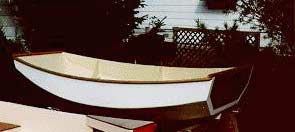
In 1997 I built a Rubens Nymph. It was for a gentleman
who’s wife had MS, was not exactly up to scampering about
on a dinghy and therefore needed a bit more stable platform.
Because this was to be a tender to a larger boat, I built her
SOLID and gave her a ‘Yacht’ finish. The transoms
were 3/4 ply, Mahogany stained, sealed with epoxy, and sheathed
with an extra layer of 6 ounce glass. In addition, ½
inch ‘top plates’ {with bronze screws for easy replacement}
were bedded on to protect the edges. To protect the epoxy, 4
coats of Spar varnish were applied. The framing was almost as
stout - ½ inch ply solidly filleted in place - with draining
limber hole openings cut at the hull ‘knuckle’.
The ‘for & aft’ thwart was 12 inches wide and
3/4 inch thick Philippine Mahogany. This got 6 coats of a UV
resistant varnish. The ‘mid section’ was cut out
so when boarding you could step right down on the hull. The
hull itself was the ‘standard’ 1/4 inch ply. Gunnels
were two layers of plain pine, for easy replacement, and oiled.
The finish was 2 coats of white primer, and 2 coats of Pettit
EasyPoxy White. It was ‘wrapped’ around the transoms
to a 2 inch border on the ‘Mahogany’.
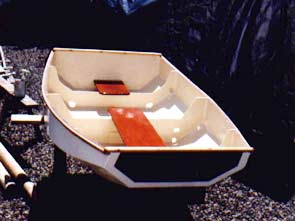
Earlier this month I got a strange telephone call.
Turned out to be the gentleman who had purchased the Rubens
Nymph!! He loved the boat, and it had preformed it’s function
beautifully. With this, that, and the other, it turned out that
he had been required to move rather quickly. During the relocation,
the movers had somehow broken off the skeg, could it be replaced
? When I gave a qualified, “yes” {I hadn’t
seen the boat yet} we became involved in a nice discussion.
It seems his move had him living about 30 minutes away from
me. He offered to bring the boat over the next day. I begged
off because I wanted to make room in the shop, plus our area
was having torrential rain storms. We arranged that I would
call him in a couple of days and make arrangements to come out
on Saturday morning & inspect the boat & damage.
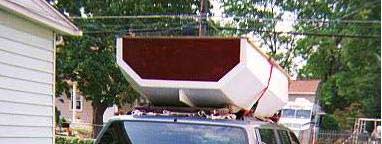
A few days later - when I called to arrange a
time - the owner was ‘heartsick’ when he described
further, and VERY EXTENSIVE, damage.
The boat had normally been stored, I was told, up on cinder/cement
blocks, at least a foot above the ground, with a tarp thrown
over it. In this instance, the boat was placed {upside down}
directly on the ground - a heavy, damp, clay soil. The outcome
was that, although appearing simply dirty on the exterior, BOTH
TRANSOMS were ROTTED OUT on the inside. Even completely missing
in about 25% of the area. Of the ‘top plates’ there
is no indication. Either they rotted completely away, or they
may have been removed some time age. {In fact, it was in looking
over my notes & original photos that I noticed them !!}

There is almost no strength or integrity left
in the wood. However, the sides and bottom {sheathed 1/4 inch
Mahogany ply}, plus the fillets at the transoms, are holding
the hull form/shape. So much so that the boat can be turned
over, or on it’s side, and moved. It is this that gives
me an idea for a possible method of repair.

First, I would recommend the use of 3/4 inch MDO
- Double Sided. 1 to 2 inch thick spacers would be placed on
the INSIDE SURFACES of what is left of the existing transoms.
Dimensions and angles will be taken off the existing interior
sides/bottom surfaces, at the level of the spacers. NEW transoms
will cut to these measurements. The mating surfaces will be
prepped and the new ones fastened & filleted in place. After
the epoxy has cured, the original transoms - and the
ends of the side/bottom panels - will be cut off. The remaining
material will be trimmed flush with the NEW transoms.
Epoxy & fiberglass sheathing will be applied, and integrated
into the existing sides/bottom panels.

In addition to the transom repair I will propose
a re-furbishment project to Clean, Sand and Re-Paint the hull.
Remove and Replace the gunnels {which seem a bit ‘soft’}.
Also, the ‘original’ problem - Replace the missing
Skeg - I would use OAK, properly Sealed & Bedded.
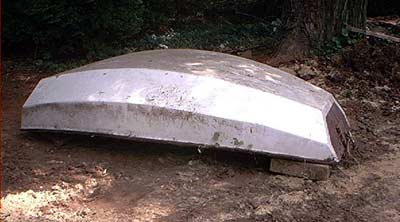
This process will shorten the LOA by about 4 inches.
I contacted both Phil Bolger and Dynamite Payson. Phil considers
the effect of this “negligible” for either rowing
or sailing {the owners present desire}. However, they are both
in agreement - “. . . a lot of time & work . . . {more
economical} to simply build a new Rubens Nymph”. {Granted,
even if effectively repaired, the increased stress of a leeboard
and rudder in the water may NOT be the best thing for
a hull that has been neglected !}
One of the things I noticed was that the owner had installed
lifting handles and a bow eye {see photos}. He had neither sealed
the holes or bedded the fittings. I have a feeling that some
of the rot fungus entered here. I also got the impression that
the transoms were placed DIRECTLY on the cinder blocks - no
intervening wood block or padding. I didn’t ask, but the
‘thrown over’ tarp may have draped over onto the
ground. I mention this because the rough surface of the blocks
would scrape through any finish, moisture would have wicked
up through the blocks right into the wood. The placement of
the tarp made the situation even worse - it would not allow
air circulation.
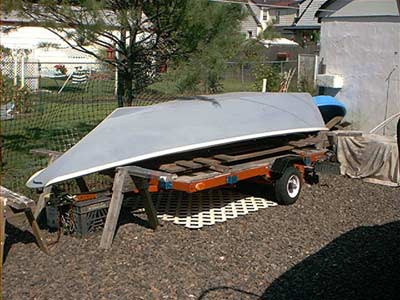
As opposed to this, here is how I ‘dry store’ a
South Haven Dory. There is no padding on the ‘horses -
it’s awaiting work and the gunnels will be refurbished.
Besides, in this case, rug scraps {cheap & good for ‘long
term use’}would hold rain water in contact. Note that
it is NOT sitting on the trailer {what looks like fencing is
actually the side & back frames} - there is spacing to allow
complete air circulation. While the trailer was folded up &
wrapped up during the winter, the dory was simply covered with
a green ‘Farm Tarp’. Padding was placed on the ‘horses
and the tarp was arranged to leave the ends and ‘bottom’
{inside} open. No place for water or melting snow to get in,
but plenty of dry air. Plus I frequently looked at her and brushed
snow off. She is ‘dry as a bone’ and ‘solid
as a rock’ . . . even the broken ‘Tombstone’
transom has no rot.
Yes, it’s still August. Of course we’re still ‘on
the water’ or in ‘Building Mode’. However,
I just RSVP’d for the Dragon’s Labor Day Picnic
. . . a day late because THIS Saturday
snuck up on me. Yesterday we gave the ‘pups’ their
Fall bath, but you people with 2-legged children are involved
with the on-going panic of back-to-school preparation. Next
thing you know it will replacing that broken leaf rake or blower
- “. . . their collecting the leaves WHEN
!! “.
Hey, don’t mean to sound like the ‘Grinch’.
I try to wear shorts and Hawaiian shirts right up until I have
to put on the insulated ‘jump suit’ coveralls. Just
a friendly reminder, from an inveterate procrastinator, take
care of your babies.
Don’t wait until that one morning when you wake up, look
out the window, and see about 6 inches of ‘a dusting’,
and say . . . “Damn !! I should have / meant to / was
going to . . . “. That’s O.K. - send me an ‘e-note’.
I’ll be here, my feet up, in old deck shoes, a ‘boat
drink’ in hand, a slight smile on my face, and a smart-ass
“I told you so” on my lips.

